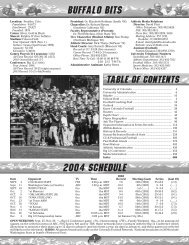FOOTBALL GAMEDAY MAGAZINE - of College Football Games
FOOTBALL GAMEDAY MAGAZINE - of College Football Games
FOOTBALL GAMEDAY MAGAZINE - of College Football Games
You also want an ePaper? Increase the reach of your titles
YUMPU automatically turns print PDFs into web optimized ePapers that Google loves.
WE ARE SPARTANS<br />
miChigAn stAte FootbALL<br />
UniVersitY sPotLight<br />
msU Archaeology team’s latest find:<br />
16,000-year-old sand dune<br />
By Andy Henion, University Relations<br />
About 16 millennia ago, when the ice sheets melted<br />
on what would become Michigan State University’s<br />
campus, tons <strong>of</strong> sand and other sediment were left<br />
behind on a barren, wind-swept landscape.<br />
Fast forward 16,000 years, and a team <strong>of</strong> MSU<br />
researchers and archaeology students has confirmed<br />
the existence <strong>of</strong> an undisturbed, prehistoric sand dune<br />
beneath a grove <strong>of</strong> pine trees between Demonstration<br />
Hall and Munn Ice Arena.<br />
“The MSU campus is an odd place in Michigan<br />
to find a sand dune,” said Alan Arbogast, an MSU<br />
geography pr<strong>of</strong>essor who helped determine the dune’s<br />
age. “This is the first time I’ve ever seen an inland dune<br />
this far south.”<br />
The dune is one <strong>of</strong> the latest finds <strong>of</strong> the Campus<br />
Archaeology Program, said director Lynne Goldstein.<br />
The team also recently discovered parts <strong>of</strong> MSU’s first<br />
building, <strong>College</strong> Hall, a classroom/<strong>of</strong>fice structure<br />
built in 1856 on the present site <strong>of</strong> Beaumont Tower.<br />
Campus Archaeology, run by the Department <strong>of</strong><br />
Anthropology and made up mostly <strong>of</strong> undergraduate<br />
and graduate students, is committed to identifying<br />
historic and prehistoric sites across the sprawling<br />
5,200-acre campus. While most sites discovered<br />
relate to the early years <strong>of</strong> MSU, some date further<br />
back to Michigan’s early pioneer period and others are<br />
Native American sites.<br />
The program got its start in 2005 with the muchpublicized<br />
excavation at the former site <strong>of</strong> Saints’ Rest,<br />
MSU’s first residence hall. The dig team discovered<br />
a host <strong>of</strong> artifacts, including iron woodstoves, glass<br />
medicine bottles and a toothbrush made <strong>of</strong> bone.<br />
Charlotte Cable <strong>of</strong> MSU’s Campus Archaeology Program brushes soil from the foundation <strong>of</strong> <strong>College</strong> Hall,<br />
recently discovered on the present site <strong>of</strong> Beaumont Tower. Photo by Kurt Stepnitz<br />
78 w w w .ms u s p a r t a n s .co m<br />
Goldstein, a pr<strong>of</strong>essor <strong>of</strong><br />
anthropology, said she’s not aware<br />
<strong>of</strong> any other U.S. university “taking<br />
the stewardship <strong>of</strong> its campus as<br />
seriously as MSU.” Typically, she<br />
said, universities and colleges<br />
conduct excavation projects only<br />
on special occasions or if state or<br />
federal laws require it.<br />
“MSU is the only place I know<br />
<strong>of</strong> that has chosen to do this not<br />
because anybody required us to<br />
do it, but because the university<br />
decided it was the right thing to<br />
do,” Goldstein said.<br />
The sloping land on which the<br />
sand dune rests was purchased<br />
by then-Michigan Agricultural<br />
<strong>College</strong> in 1913. At that time the<br />
dune was exposed and eroding on the developing<br />
campus, so the following year forestry pr<strong>of</strong>essor Frank<br />
Sanford planted a variety <strong>of</strong> pine and spruce, which<br />
would successfully stop the erosion. Initially about four<br />
acres, the plot has been reduced by development to<br />
about one acre.<br />
As generations <strong>of</strong> Spartan fans have made their<br />
way through the trees en route to football, hockey<br />
and basketball games, it was widely known that sand<br />
made up the hill underneath the pine needles. What<br />
wasn’t known was the age <strong>of</strong> the sand.<br />
Then, in spring 2009, MSU’s Landscape Services,<br />
a division <strong>of</strong> Physical Plant, had to replace stormdamaged<br />
trees on the grove. Goldstein<br />
and her team coordinate with Physical<br />
Plant to determine if construction or<br />
planting will destroy any archaeological<br />
sites, and regularly conduct surveys<br />
and excavations to identify these<br />
sites. With the dune, they were able to<br />
examine the sand in two holes (about 4<br />
and 8 feet deep) without the need for<br />
a full-scale dig and without harming<br />
existing trees.<br />
To determine the age <strong>of</strong> the sand,<br />
Goldstein brought in Arbogast, an<br />
expert on Great Lakes sand dunes. A<br />
visual inspection convinced Arbogast<br />
the dune was very old based on the<br />
existence <strong>of</strong> lamellae – or wavy, reddish<br />
bands that run through the sand and<br />
indicate long-term soil formation.<br />
The next step was collecting two<br />
Students walk through the grove <strong>of</strong> trees between Demonstration Hall and Munn Ice Arena. A prehistoric sand<br />
dune was recently discovered beneath the trees. Photo by Kurt Stepnitz.<br />
samples <strong>of</strong> unexposed sand and sending them <strong>of</strong>f<br />
to the University <strong>of</strong> Nebraska-Lincoln for optically<br />
stimulated luminescence, or OSL, dating. Arbogast<br />
said the process measures the amount <strong>of</strong> ionizing<br />
radiation that sand grains emit to estimate the last time<br />
they were blowing and exposed to light.<br />
The results showed the MSU samples were between<br />
16,100 and 12,400 years old. Based on what is known<br />
about the area’s glacial history and Michigan dunes,<br />
Arbogast concluded these ages most likely mean the<br />
dune was formed shortly after the ice retreated from<br />
the area about 16,000 years ago.<br />
“The dune probably formed because northwesterly<br />
winds blew sands up from the prehistoric floodplain <strong>of</strong><br />
the Red Cedar River, which likely also formed shortly<br />
after the ice melted,” Arbogast said.<br />
In addition to the rarity <strong>of</strong> a dune in southern inland<br />
Michigan, it’s also uncommon to find a stretch <strong>of</strong><br />
land on the MSU campus that hasn’t been modified<br />
over the years, said Terry Brock, who, as campus<br />
archaeologist, helps Goldstein run the Campus<br />
Archaeology Program.<br />
“Something we’ve discovered during our<br />
excavations over the past couple years is that this<br />
whole campus is seriously modified. Even the parts<br />
that look natural – the older parts <strong>of</strong> campus – have<br />
been greatly modified,” said Brock, a doctoral student<br />
in anthropology.<br />
“But the only modification the pine grove has<br />
received is to have trees planted on it, and that was<br />
to keep the sand from blowing away,” Brock added.<br />
“Everything under the trees is completely natural.”<br />
The pine grove will not be dug up further, Goldstein<br />
said, as to not disturb the trees.

















